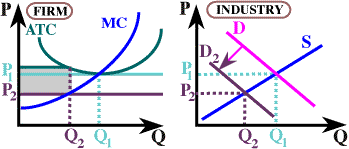
Clearly what is happening here is a reduction in demand. Warmer temperatures would naturally lead to reduced demand for wool socks. As we learned earlier, in perfect competition this causes the industry demand curve to shift back, lowering price and leading to short run losses (negative profits) in the short run.
The graph below illustrates the short run effect of a reduction in demand in a perfectly competitive industry:
